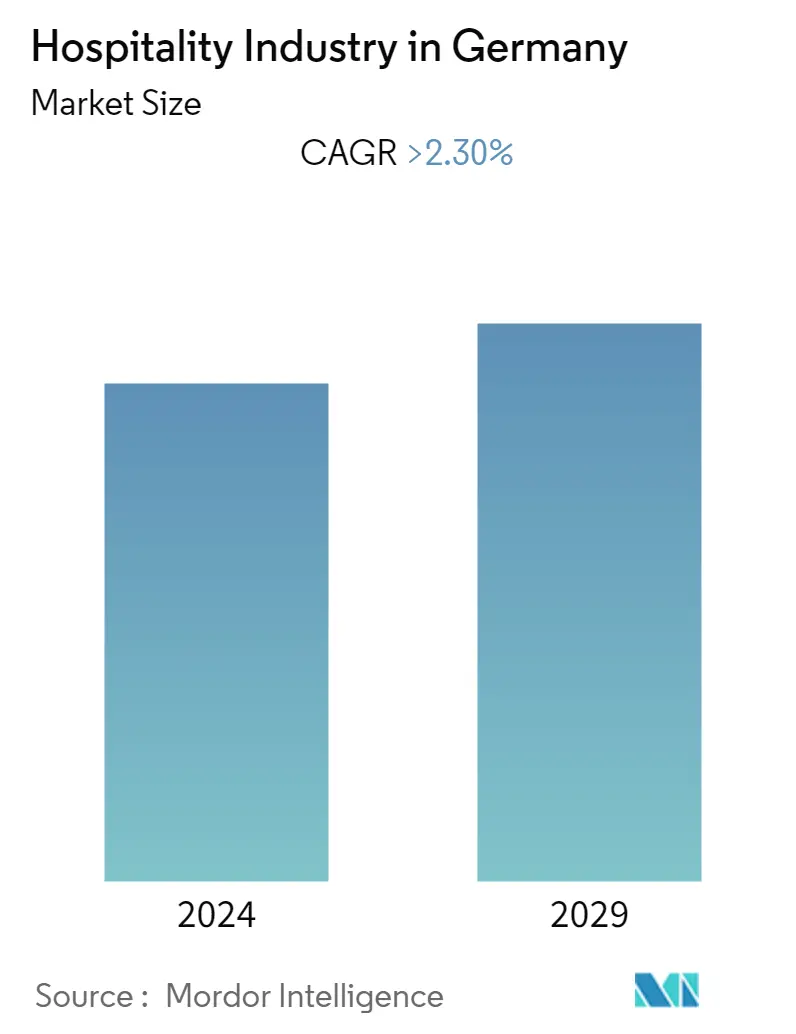Market Size of Hospitality Industry in Germany

| Study Period | 2019 - 2029 |
| Base Year For Estimation | 2023 |
| Forecast Data Period | 2024 - 2029 |
| Historical Data Period | 2019 - 2022 |
| CAGR | > 2.30 % |
Major Players
*Disclaimer: Major Players sorted in no particular order |
Germany Hospitality Market Analysis
- The hospitality industry in Germany is dynamic and growing. In 2018, the industry witnessed an addition of more than 16,000 rooms and 200 hotels.
- With the increasing number of tourist arrivals, the hospitality industry is projected to grow further in the future. Travelers from abroad spent more than 39 million nights in the country during the first half of 2019, which was 3% more when compared to the same period in 2018, according to Germany's Federal Statistical Office.
- Domestic tourism is also increasing rapidly in the country. In the first half of 2019, the overall overnight stays by Germans within their home country rose by 4% to around 182 million, as compared to the same period in 2018.
- Germany has been recording an increasing number of leisure trips and business trips. The country is home to a number of companies, with more than 200 brands that are spread across Germany.
- Germany is also home to a large number of independent hotels with more than 20,000 hotels that perform independently and cover all the segments. The international brands have their footprints all over the leading tourist destinations, with a high number of rooms; however, domestic brands have their presence in the tier-II cities, with good market coverage.
Germany Hospitality Industry Segmentation
The report covers a complete background analysis of the hospitality industry in Germany, including an assessment of the industry associations, overall economy, emerging market trends (by segment), significant changes in the market dynamics, and market overview.
| Type | |
| Chain Hotels | |
| Independent Hotels |
| Segment | |
| Service Apartments | |
| Budget and Economy Hotels | |
| Mid- and Upper Mid-scale Hotels | |
| Luxury Hotels |
Hospitality Industry in Germany Size Summary
The hospitality industry in Germany is experiencing significant growth, driven by an increase in both international and domestic tourism. The country has seen a rise in tourist arrivals, with travelers from abroad spending millions of nights, and a notable increase in domestic overnight stays. This growth is supported by a robust presence of both international and independent hotels, with international brands expanding their footprint in major tourist destinations like Berlin, Munich, and Frankfurt. The industry is characterized by a mix of independent and branded hotels, with international chains such as IHG planning to significantly increase their presence through new hotel projects. This expansion is facilitated by mergers and acquisitions, which have bolstered the market position of international brands.
Germany's hospitality sector is marked by a dynamic landscape where international brands have gained a substantial presence, contrasting with the historical dominance of domestic brands. The market is not only growing in major cities but also in tier-II cities, where domestic brands have established a stronghold. The increasing brand penetration rate reflects the rising number of tourist activities, both leisure and business, across the country. The construction pipeline for new hotels indicates a continued focus on expanding capacity to meet the growing demand, particularly in leading cities. This growth trajectory positions Germany as a key player in the European hospitality market, with a balanced mix of international and domestic brand presence.
Hospitality Industry in Germany Market Size - Table of Contents
-
1. MARKET INSIGHTS AND DYNAMICS
-
1.1 Market Overview
-
1.2 Market Dynamics
-
1.2.1 Drivers
-
1.2.2 Restraints
-
1.2.3 Opportunities
-
-
1.3 Impact of COVID-19 on the Hospitality Industry
-
1.4 Insights into Revenue Flows from the Accommodation and Food and Beverage Sectors
-
1.5 Leading Cities in Germany, with Respect to Number of Visitors
-
1.6 Investments (Real Estate, FDI, and Others) in the Hospitality Industry
-
1.7 Technological Innovations in the Hospitality Industry
-
1.8 Insights into the Impact of Shared Living Spaces on the Hospitality Industry
-
1.9 Insights into Other Economic Contributors to the Hospitality Industry
-
1.10 Value Chain Analysis
-
1.11 Porter's Five Forces Analysis
-
-
2. MARKET SEGMENTATION
-
2.1 Type
-
2.1.1 Chain Hotels
-
2.1.2 Independent Hotels
-
-
2.2 Segment
-
2.2.1 Service Apartments
-
2.2.2 Budget and Economy Hotels
-
2.2.3 Mid- and Upper Mid-scale Hotels
-
2.2.4 Luxury Hotels
-
-
Hospitality Industry in Germany Market Size FAQs
What is the current Germany Hospitality Market size?
The Germany Hospitality Market is projected to register a CAGR of greater than 2.30% during the forecast period (2024-2029)
Who are the key players in Germany Hospitality Market?
Accor SA, InterContinental Hotels Group, Marriott International, Inc, Deutsche Hospitality and Maritim Hotelgesellschaft mbH are the major companies operating in the Germany Hospitality Market.

